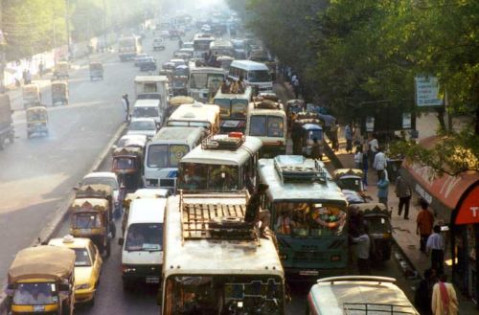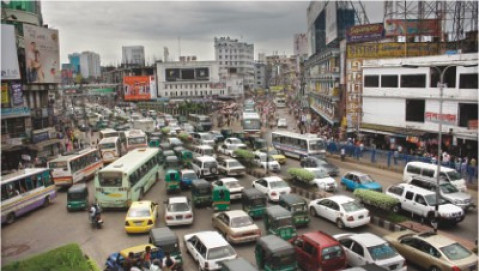Widgetized Section
Go to Admin » Appearance » Widgets » and move Gabfire Widget: Social into that MastheadOverlay zone
Air Pollution Kills 195,000 Bangladeshis Each Year
The Role of Public Administration and Governments Integrity
Shakeel Ahmed Ibne Mahmood
The Problem
Air pollution kills 195,000 Bangladeshi each year, according to World Health Organisation (WHO) 2016 estimates.
In 1995, the average ozone concentration in Mexico City was about 0.15 parts per million, 10 times the natural atmospheric concentration and twice the maximum permitted in Japan or the United States. The density of lead in the air of Dhaka is 463 nanograms per cubic metre, which is 10 times more than the acceptable standard and several times more than the above-mentioned cities, even than the most polluted city of Mexico.
The large number of children, street children, local streetwalkers, and rickshaw pullers in Dhaka City are at particular risk from this air pollution. Young children are mostly exposed to cadmium through inhalation of smoke and contaminated soils and dust from industrial emissions and sewage sludge. In 1999 environmental scientists said that the high lead in the environment from gasoline, paints, ceramics, batteries, etc. are factors in the increased risk of polluted air. Another study revealed that blood lead levels were very high and at toxic levels in children presenting with psychomotor delay and behavioral problems, indicating lead poisoning.
There are two major sources of air pollution in Bangladesh: Vehicular emissions and industrial emissions. These are mainly concentrated in the cities. There are also many brick-making kilns operated seasonally, mainly in dry season all over Bangladesh. Most of these kilns use coal and wood as their prime sources of energy, resulting in the emission of particulate matter, oxides of sulfur, and volatile organic compounds. Additionally used rubber wheels of vehicles are burnt, which produce black carbon and toxic gases. These are harmful for health. In order to accommodate the growing population, the construction of high-rise buildings is growing rapidly. Along with these buildings, the numbers of slums are also growing. The tremendous force of population has made it almost unfeasible to maintain a clean environment in the capital city of Dhaka.
Dhaka is also one of the most densely populated cities in the world, with an estimated population of more than 8 million. Air pollution has emerged as an acute problem in the city. Blackening of the city air and reduced visibility can be observed at times. Occurrence of choking smells and irritated eyes are common, as mentioned by Khaliquzzaman, in his report, which was published at the Consultative Meeting on Integrated Approach to Vehicular Air Pollution Control in Dhaka held between April 26-27, 1998. According to the WHO report 2001, the lead concentration found in the blood of children in Dhaka was up to four times higher acceptable levels.
A Report by Akhtar Ahmed, which was presented in 1st National Conference on Environmental Health in Bangladesh in 2002 revealed that automobiles (auto rickshaws, trucks and buses, baby taxis, tempos and motor cycles), industrial emissions, bad civic practices and poor government services are some of the factors causing Bangladesh’s polluted air.
NGOs’ and Bangladesh Government’s involvement
Organizations like BAPA (Bangladesh Poribesh-Dhuson Andolon–Bangladesh Environmental Improvement Organization) and BES (Bangladesh Environmental Society), as well as many others, are working very hard individually or in collaboration with each other to remove air quality problems by arranging seminars, organizing rallies, writing papers, creating awareness on air pollution and doing research how to reduce air pollution.
According to UNEP report, which was published in 2001, the government of Bangladesh has started bringing cities under air quality monitoring network with support from the donor agencies. State of air pollution of these cities will be regularly communicated along with health advisory to the people to create more awareness through electronic and print media. A follow up project on Air Quality Management will be undertaken with the financial assistance from the World Bank. It will also look into indoor air pollution, industrial process improvement with focus on change of technology of brick kilns, introduction of environment friendly public transport system and capacity building for air quality management. The daily newspaper, Holiday, mentioned in 2010 that the Department of Environment (DOE) is working to revise the brick burning act by mid 2011 through stakeholder consultations and review of the regional experience. DOE has also been taking measures to strengthen its newly established Air Quality Cell (AQC) for better air quality management. The World Bank’s total commitment for the 5 year project is $62.20 million. However, the bank gave Bangladesh $4.7 million in July 2000 to fund an air quality management project. It also supported a program to train drivers how to reduce emissions.
Current Situation
Bangladesh is one of the least developed nations in the world. Since it’s beginning (1971), there has been some growth in the industrial sector. Industries are mainly concentrated in major urban metropolitan areas such as Dhaka and Rajshahi; seaport cities such as Chittagong and Khulna; the inland port city Narayanganj; and other divisional towns. Obviously, the air pollution problem is more severe in these areas. Apart from unplanned industrial development in these areas, the severity of the pollution is increased mainly due to exhausts from two-stroke engine and diesel-run vehicles.
The newspaper, New Nation, published in 2010, mentioned that the pollution-vomiting vehicles (20 to 25 years old vehicles) are again on the high roads. Many owners have changed bodies of their old buses and also tinted those but the engines are the same. These unfit busses are creating traffic jam and making the air polluted by blowing up black smoke, causing serious health hazards to the commuters. Recently, the government has decided to launch a drive in Dhaka city to remove 25-year-old buses, minibuses and trucks from the street as one of the measures to ease the nagging traffic congestion according to a 2010 article from Daily Star, a Bangladeshi newspaper. The New Age newspaper mentioned in a 2010 article that this drive, mainly aimed at solving traffic jam and checking environment pollution, would certainlyhelp to reduce air pollution in the city, too.
The Department of Environment (DOE) recently signed an agreement with the Norwegian Institute of Air Research (NILU), under which Bangladesh will receive a $1.3 million U.S. dollars grant for air quality and research. The grant will be utilized for aid quality monitoring across the country, a first ever study on the country’s air quality impact on health, inventorying the sectoral emission and green house gases (GHGs), air quality modeling and development of an air quality forecasting system. It is the city’s moral duty to protect its people from any kind of health related problems. Paying no attention to these issues results in grief and death. What we foresee, 10 years from now, is that our young children won’t be able to smell what their mothers are cooking. Rather, they will be inhaling and exhaling only polluted air. One has to remember that the arrogant roar of an engine can easily drown the crying of a child.
The level of lead poisoning is a major factor responsible for decreasing the mental abilities of the children as a result of which the country will have acute shortage of intellectuals in the long run. The only way to enhance the ethical accountability of public administration is the Bangladesh government should immediately translate its National Environmental Policy and Transport Policy into action.
ASPA member Shakeel Ahmed Ibne Mahmood, The University of Maine, is also a member, BAPA, (Bangladesh Environmental Improvement Organization). Email: [email protected]







 (15 votes, average: 3.67 out of 5)
(15 votes, average: 3.67 out of 5)
Spencer Haywood
October 30, 2020 at 1:58 pm
There are no other comments on this article so I’ll give my opinion.
Julius Oppenheimer
July 13, 2020 at 9:29 pm
Just get a large fan and blow the bad air into the mountains
Phil Russell
June 14, 2020 at 2:20 pm
Disgraceful. The few countries who are helping with this crisis are contributing almost nothing. Why even bother donating if their heart is not in their actions?
Morgan Jordan
June 5, 2020 at 12:24 pm
Is 195,000 an accurate statistic? Seems on the high side
Ken Griffey Sr.
May 24, 2020 at 1:13 am
This is indeed a very serious problem
Ty Cobb
May 18, 2020 at 2:01 pm
I was going to annoy you with an essay on Tokyo Ghoul but you have been spared for now.
Ty Cobb
May 18, 2020 at 12:37 pm
Too bad the government does not seem to care about this enough to take any real steps to fix it.
Jeene
March 8, 2019 at 8:46 am
How very unfortunate, this country is extremely poor and lthe
environment is toxic. Instead of the countless deaths, what about some
form of birth control? How about teaching them ways to improve their lives?
Sure the statistics are obvious but what can be changed today?
Adess Singh
November 4, 2018 at 1:09 pm
Our innovation CentriAirFlow had been awarded the national Award in 2014 and has now been cleared at the Clean Technology Organization (CTO) event at California, for the Global Event to be held in San Francisco in January 2019.
The World Health Organization in a detailed study has concluded that 7 million people die premature deaths due to vehicular pollution each year. Presently available technology, because it uses resistive filters, suffers from an inverse relationship. If particulate matter is reduced, NOx and CO and fuel consumption is increased. If NOx is reduced particulate matter is increased.
In any case, world over, there are 1.2 Billion on road four wheelers (with 260,000 added each day) with service life of over 12 years which cannot be wished away and will continue to pollute as present technology and any new technology does not address the on road vehicles.
For the first time, with CentriAirFlow10000g, the following objectives are achieved simultaneously:
1) Removes particulate matter from engine exhaust
2) Reduces NOx and CO emissions.
3) Reduces fuel consumption by 12% to 15%
4) An environment upgrade is made available at reduced total cost and also saves money for the owner.
The innovation fits all engines irrespective of the vintage of the engine or the type of fuel used.
Adess Singh
Mobile Number +91 9417016945
fish
October 25, 2018 at 9:27 am
wow man